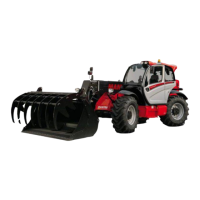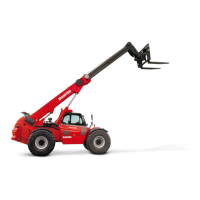1 - 17
D - TRANSVERSE ATTITUDE OF THE TELEHANDLER
Depending on the model of telehadler
The transverse attitude is the transverse slope of the chassis with respect to the horizontal�
Raising the jib reduces the telehadler's lateral stability� The transverse attitude must be set with the jib in down position as
follows:
1 - TELEHANDLER WITHOUT ROLL CORRECTOR USED ON TYRES
- Position the telehadler so that the bubble in the level is between the two lines (
e 2 - DESCRIPTION: CONTROL AND
COMMAND INSTRUMENTS)�
2 - TELEHANDLER WITH ROLL CORRECTOR USED ON TYRES
- Correct the roll using the hydraulic control and check horizontality with the spirit level� The bubble in the level must
be between the two lines (
e 2 - DESCRIPTION: CONTROL AND COMMAND
INSTRUMENTS)�
3 - TELEHANDLER USED ON STABILIZERS
- Set the two stabilizers on the ground and raise the two front wheels of the telehadler
(fig� D1)�
- Correct the roll using the stabilisers (fig� D2) and check horizontality with the spirit
level� The bubble of the level must be between the two lines (
e 2 - DESCRIPTION:
CONTROL AND COMMAND INSTRUMENTS)� In this position, the two front wheels
must be off the ground�
E - TAKING UP A LOAD ON THE GROUND
- Approach the telehadler perpendicular to the load, with the jib retracted and the
forks in a horizontal position (fig� E1)�
- Adjust the fork spread and centering relative to the load to ensure stability (fig� E2)
(optional solutions exist, consult your dealer)�
- Never lift a load with a single fork�
t
IMPORTANT
t
Beware of the risks of trapping or squashing limbs when manually adjusting the forks.
- Move the telehadler forward slowly (1) and insert the forks under the load as far
as they will go (fig� E3)� If necessary, slightly lift the jib (2) while taking up the load�
- Bring the load into the transport position�
- Tilt the load far enough backwards to ensure stability (loss of load on braking or
going downhill)�
FOR A NON-PALLETIZED LOAD
- Tilt the carriage (1) forwards and move the telehadler slowly forwards (2), to insert
the fork under the load (fig� E4) (block the load if necessary)�
- Continue to move the telehadler forwards (2) tilting the carriage (3) (fig� E4)
backwards to position the load on the forks and check the load's longitudinal and
lateral stability�
E1
E2
1
2
E3
1
2
3
E4
D2
D1

